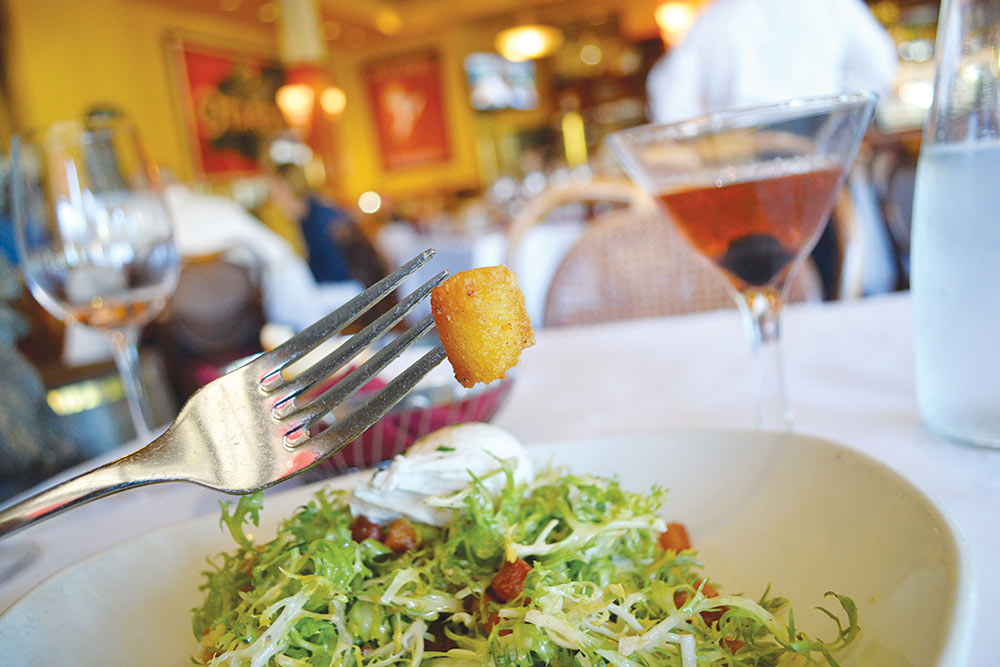The Paris Metro it may not be, but Sonoma–Marin Area Rail Transit has one feature in common with that other transit system: It’ll take you to a really good brasserie.
It’s a smart way to catch a six o’clock dinner reservation in Larkspur from points north, without the hassle of rush hour traffic. The only hitch is the so-called “last mile” of the trip, or rather, about five miles, in this example. But they’re easily covered on à bicyclette, by way of mostly off-street paths between the San Rafael station and Left Bank Brasserie in downtown Larkspur—a commercial stretch of such brevity that I cycle right on by the big, and indeed blue, Blue Rock Inn building on my first go-round.
It’s entirely unnecessary to carry a baguette under my arm on this trip, because the Brasserie has that covered with fresh white and wheat slices from Acme Bread. Served with butter. Creamy butter.
Speaking of butter, the requisite escargot ($12) are cooked in Pernod garlic butter, and what do they say about what to do, when you’re in Paris?
Sorry, no. Because this is still Larkspur, and because I’m an unadventurous rube culinarily speaking, and also because during the previous day’s media lunch someone mentioned eating banana slugs on a juvenile dare, I pass on the Gallic specialty. It helps that chef David Bastide nudges me toward the smoked salmon rillette ($15) appetizer, a dish whose only defect is not offering enough toast points for the veritable salad of salmon with cucumber, tomato and onion.
Bastide, whose full title is Maître Cuisinier de France, happens to be in town to help the kitchen with the new, seasonally-focused menu. I take the opportunity to ask, with generous lack of couth, “So, someone referred to Left Bank as a chain—what do you call it?”
Bastide explains that two locations closed after the 2008 financial kerplop, and only two other Left Bank restaurants remain—in San Jose and Menlo Park. Larkspur is the flagship location, this year celebrating its 25th anniversary. The restaurant sure looks at home in this historic spot, and so do the patrons, settling in at tables, booths, outdoor seating overlooking Magnolia Avenue and at the bar beneath a wide selection of spirits (my semi-dry Manhattan was spot-on as ordered) and a silent TV screen.
This is no restaurant review based on three anonymous visits—I don’t own enough wigs, not to mention that the critical returns on investment would diminish quickly, as I swoon over any salad that sports an egg, settled upon frisée, that’s executed to fool me into thinking it’s a dollop of fresh cream. Enter the Lyonnaise salad ($11).
And what’s this—an oversized, extra crispy bacon lardon? No. Enter the crouton.
The humble crouton is what gets me, in the end. Being of the fourth estate, I come from a station in society where croutons are dried-out crusts of bread. Maybe herbed, when fancy. But this, this rich cube of indulgently saturated bready goodness, which is not oily, but improbably light and crunchy— can this be my pièce de résistance? Or is it that the samples of Provençal rosé and Sancerre my efficient and affable server drops by with each course are now talking?
The wine list is broad, but strictly limited to California and France. Thus, there are two Malbecs—but from Cahors. And three Zinfandels, a win for the West Coast.
Twenty wines-by-the-glass are priced from $10 to $19. Chardonnay fans will find Faively Mercury ($58) and Patz & Hall Dutton Ranch ($70), among other options. A glass of basic Bourgogne rouge from Frederic Magnien ($15) is almost too light and fruity for pairing with beef Bourgignon ($29). Trout almondine ($23) and lamb shank Provençal ($29) also sound enticing. While the burger Américain ($15) is suspiciously more economical than the Frenchified raclette burger ($23), I have to go with that classic of French country cuisine, with which I have some experience. Mostly experience in ruining—even the vegetarian versions.
This beef stew of Burgundy sports halved baby carrots, button mushrooms, pearl onions, and slices of fingerling potatoes—nothing crazy here, all classic. Yet, the proof is in the pudding, or rather, the sauce, which is not like a flour-stuffed pudding at all, but like an umami dream team of wine and beef combining to make a light, intensely-flavored sauce. Quelle perfection. Alas, it’s going to take more than five miles to burn off this much bonne cuisine.








